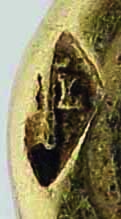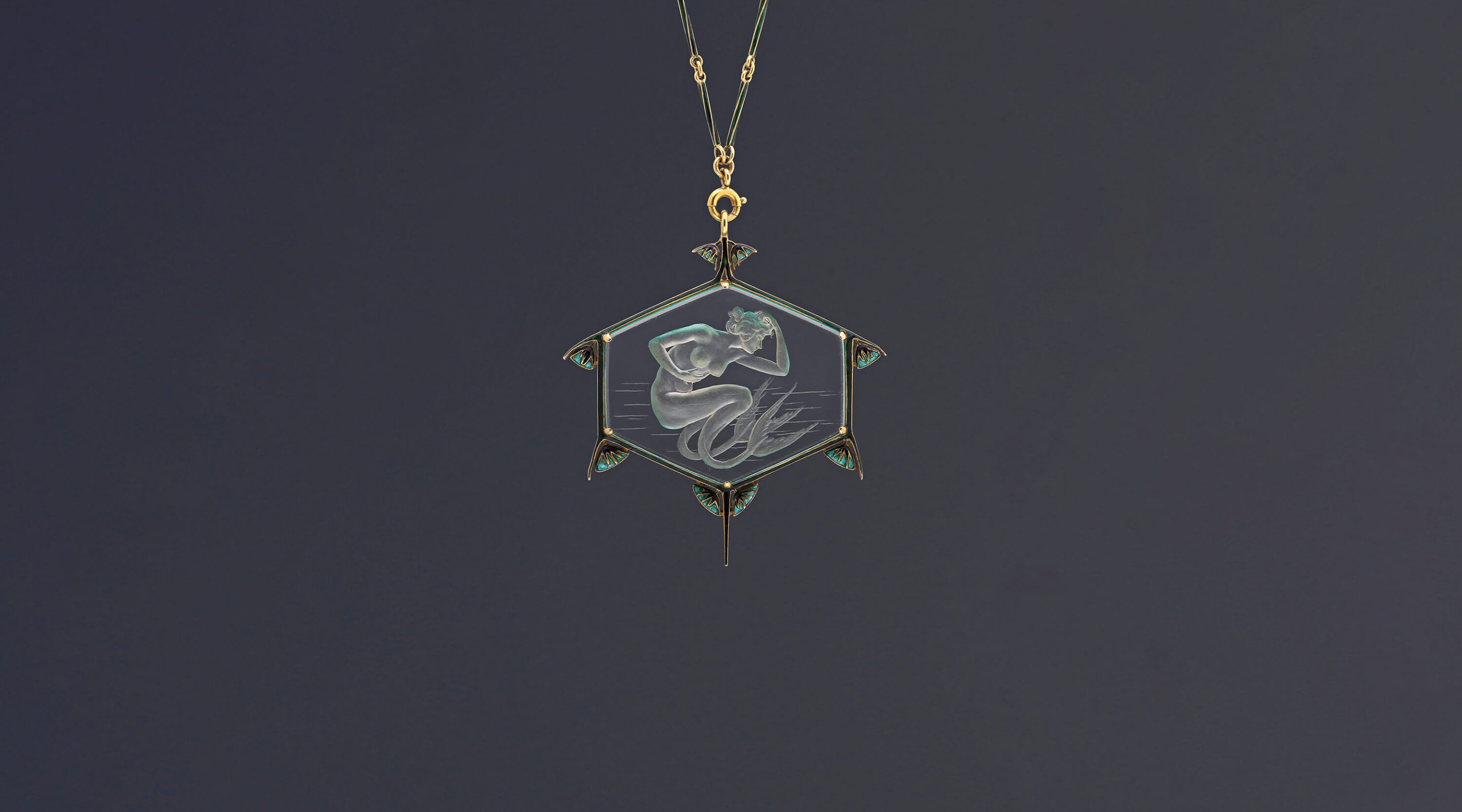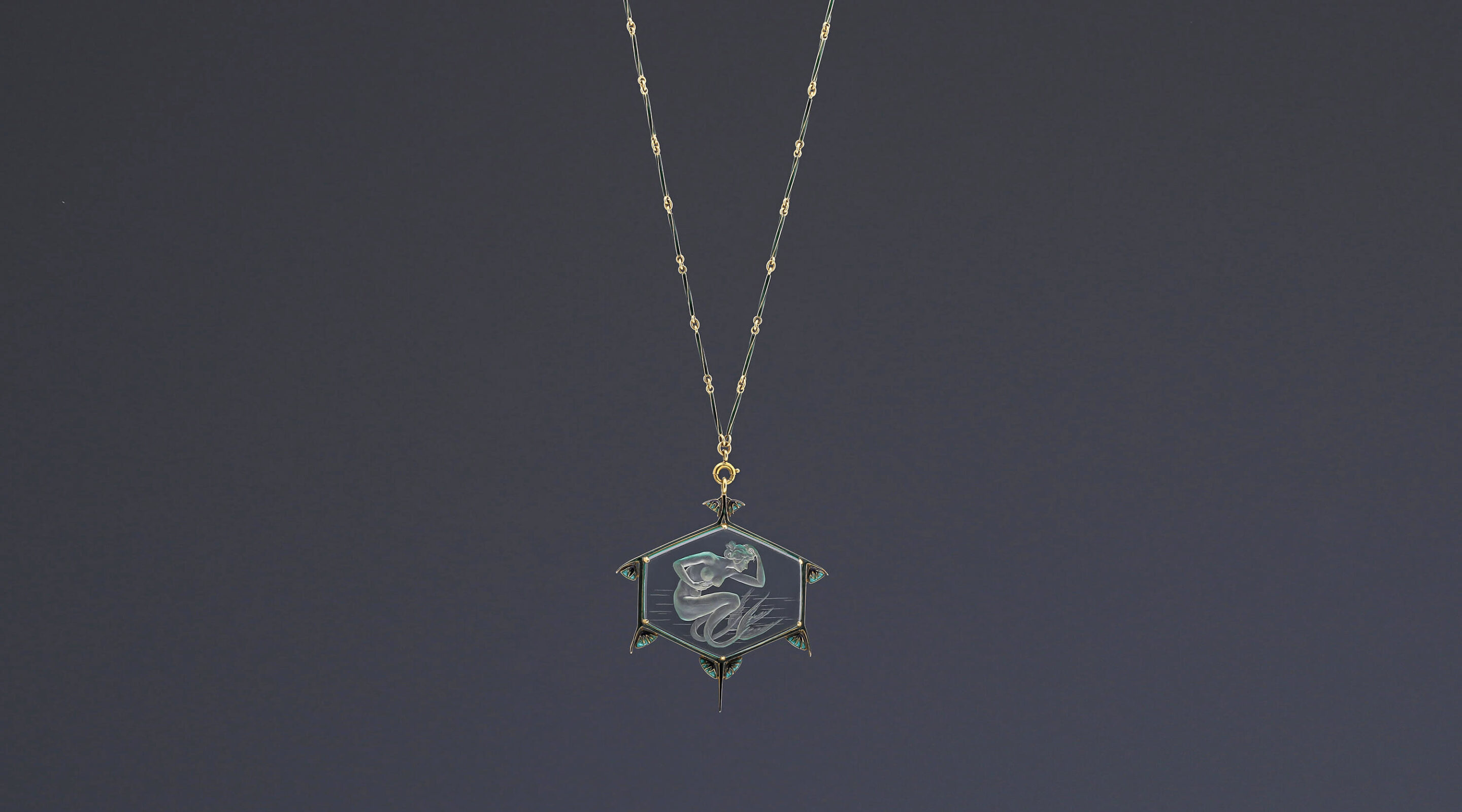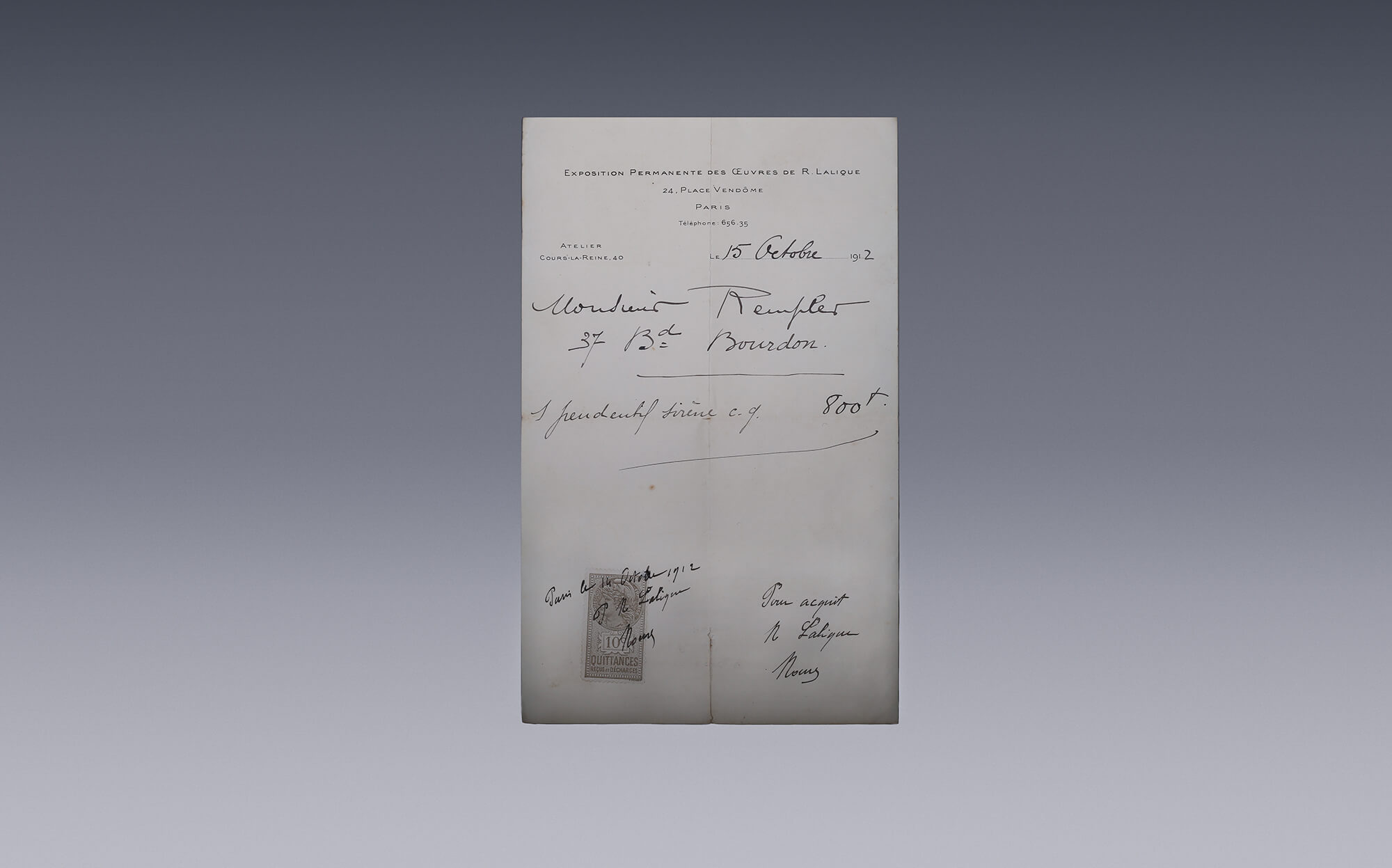René Lalique was one of the most successful makers of jewellery and glass of all time and his Art Nouveau jewellery is highly sought-after. Among the pieces he designed is this superb pendant with its original chain. This jewel, which is both signed and marked with the maker’s mark, was bought directly from Lalique. The original purchase receipt is still present, as is an image of the design drawing after which this pendant was made.
Lalique Pendant
This hexagonal pendant made by René Lalique is a very refined crystal glass reverse intaglio of Melusine, a graceful siren with a double fishtail. The eighteen-carat gold frame is decorated with enamelled thorns and thistle flowers on each corner. The original matching chain is made of linear, twisted gold sections, enamelled in green and joined by gold curb links. The colours of the enamel perfectly complement the hint of green in the glass, creating a beautifully subtle effect.
Original Receipt
This pendant has always remained in the first owner’s family and has been passed down to the most recent owners. The original receipt shows that it was bought on 12 October 1912 by Monsieur Rempler, who lived at 37 Boulevard Bourdan, near the Bastille in the 4th arrondissement in Paris. He paid 800 French francs for it in René Lalique’s elegant shop in Place Vendôme.
Design Drawing
The design drawing after which this pendant was made is pictured in the standard work Sigrid Barten wrote about Lalique in 1987, where it is dated to around 1900-02. The caption mentions a diamond-encrusted frame and a hanging square stone but is well known from Lalique’s work that the final execution of his jewels may differ.
Reverse Intaglio
The technique Lalique used in this pendant is known as reverse intaglio. Here the design can be seen under the surface of the glass. This effect is achieved by carving and engraving the image of the siren into the back of the glass. Intaglio is the opposite of cameo, where the background of the final design is cut away.
Melusine
Melusine is a water nymph or siren, often pictured as a woman with a fishtail. She is sometimes depicted with wings, two tails or both. Tales of sirens and mermaids go back into antiquity. They had a moral connotation and were used to warn men about the evil of female sexual seduction. Melusine is a recurring subject in René Lalique’s designs.
He had to leave her alone on Saturdays
In the fourteenth century, Jean d’Arras was commissioned to write Melusine’s story by Jean, duc de Berry. According to the legend, Melusine was cursed by her mother and became half serpent every Saturday until she married a man who would respect her privacy and accept her as she was. She married a nobleman, Raymondin, promising to make him rich and famous on one condition: he had to leave her alone on Saturdays. Raymondin honoured the agreement, until some of his relatives persuaded him to spy on her. When he broke his word, she left him, returning only for her children or to fulfil her obligations under the curse by warning of impending disaster or death. Melusine is associated with the dynasty of the House of Anjou of Lusignan, a powerful noble house that ruled over much of France in the 12th and 13th centuries, whom she would warn of death or changing circumstances.
Fascination with Crystal Glass
Lalique is regarded as one of the most important exponents of Art Nouveau. He was the first to make jewellery from glass rather than precious stones, a revolutionary notion around 1900. After all, jewellery made of gold and costly gemstones contributed to the status of the aristocracy and the wealthy.
Lalique believed that it was not the cost of the materials but the design and its impact that determined the value and the beauty of a piece. He was also able to experiment more with shape and colour in glass than he could with precious stones. In 1890, when he opened his third workshop in Rue Thérèse in Paris, he already began experimenting and designing with glass.
He gave glass the starring role in numerous jewels
In 1898, after his long-drawn-out divorce from his first wife, Lalique rented a glassworks in Clairefontaine, near Rambouillet, not far from Paris, where he continued his experiments with glass with the help of his good friend Jean Ringel d’Illzach. He gave glass the starring role in numerous jewels, in the form of enamel or appearing like sparkling gems. On colourless plates of crystal glass he engraved reliefs of motifs inspired by the classics, as we see in this pendant.
Talent
René Lalique (1860-1945) moved to Paris with his parents when he was two years old, but every holiday he returned to his birthplace, the village of Aÿ in the Champagne region. With his maternal grandfather he spent hours roaming around the vineyards, woods and fields, immersing himself in nature. He observed and drew what he saw. This love of nature had a lasting influence on his later artistic career. We can see from the many meticulously worked out studies for jewellery he made later that Lalique had studied, anatomized and investigated the plant and animal kingdom down to the smallest details.
London
His parents encouraged Lalique to develop his talent by sending him to drawing lessons. When he was twelve, he won first prize in a drawing competition at the Hotel Turgot in Paris. Following his training at the Ecole des Arts Decoratifs and an apprenticeship with Louis Aucoc (1850-1932), where he learnt jewellery-making techniques, he went to London and took a course at the School of Art, Science and Literature in Sydenham. It was here that he first encountered the ideas and the art of the Pre-Raphaelite Brotherhood and the influential Arts and Crafts movement that grew out of it, which, along with Japanese art, had a significant effect on him.
Paris
After his two-year stay in London, Lalique returned to Paris where his talent as jewellery designer and illustrator was immediately spotted. He received commissions from his old teacher Aucoc, as well as from Boucheron, Cartier and Maison Vever. The next step in his career was his takeover of Jules Destapes’ workshop and employees in Place Gaillon. He was able to make this move thanks to the extremely wealthy Marie-Françoise Lambert, to whom his mother had introduced him and brought about their marriage. The marriage of convenience did not last long, but Lalique was able to cause a sensation as a designer and his name was established. In 1890 he worked for René Bing and was the most important jewellery designer of Art Nouveau, with flora, fauna and female forms as his most important sources of inspiration.
Avant-Garde Jewellery for the Elite
When René Lalique showed a series of jewels with elegantly winged female figures at Bing’s stand at the 1900 Exposition Universelle in Paris, he became world-famous overnight. By then his work had already developed hugely. Alongside the traditional costly ‘noble’ materials, he incorporated other natural and cheaper materials like horn, ivory, glass, enamel and semi-precious stones in his jewellery. The value of the jewels no longer lay in the intrinsic value of the materials, but in the artistic value of the object. The avant-garde jewel for the elite was born.
Marked with the maker’s mark of René Lalique and signed Lalique, and the French control mark for 18 carat gold. With original receipt of the purchase in 1912.


This site is protected by reCAPTCHA and the Google Privacy Policy and Terms of Service apply.


